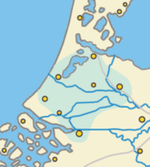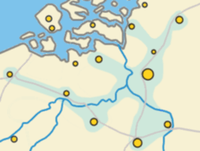History of urban centers in the Low Countries
The development of urban centers in the Low Countries shows the process in which a region, the Low Countries in Western Europe, evolves from a highly rural outpost of the Roman Empire into the largest urbanized area above the Alps by the 15th century CE. As such, this article covers the development of Dutch and Flemish cities beginning at the end of the migration period till the end of the Dutch Golden Age.
Earliest settlements

During Roman times, the Low Countries belonged to the outer provinces of the empire, situated near the Roman-Germanic border. Probably because of the (founded) fear of Germanic incursions, Roman settlements (such as Roman villas and colonies) were extremely sparse, and Roman presence was mainly limited to three Castra: (Noviomagus, near modern Nijmegen; Flevum, near Velsen; and a last one near Oudenburg, its name is unknown); and a set of Castellum. These together formed the only population centers which surpassed the native villages of the time in terms of architecture and, in some cases, population. The only possible exception was the city of Atuatuca Tungrorum, which later became one of the earliest centers of Christianity in the Low Countries.
Unsurprisingly, it was on or around the (ruins) of these Castra and Castellum that the first large settlements arose. Very little is known about these settlements, apart from archeological material, as there was little literacy at the time. Based on archeological evidence, together with sparsely preserved written text it is thought that Dorestad (build near the former Roman fortifications) was the most populous and important settlement of the region; with an estimated 3,000 inhabitants, it was much larger than the remaining villages, which often had no more than 100–150 inhabitants. Dorestad seems to have been the principal trading center of the Low Countries from around 600 CE until it started to decline around the early 9th century, caused by frequent Viking raids, wars, silting of its river connection and the emerging of new centers favored by the Franks, such as Liège, Cambrai, Soissons, Herstal, Tournai and, most to the north, the neighboring site of Nijmegen.
Sub-regional centers



From around the 10th century, mainly due to population growth and improved infrastructure, more larger settlements begin to appear. Around the 11th century, some of these cities begin to form networks of urban centers. In the Low Countries these appeared in 3 regions; at first in the County of Flanders in the South, then followed by the County of Holland in the North and Northern Guelders/Oversticht in the East. The cities located in the center of the Low Countries were able to profit of both of the Flemish and Hollandic cities and no real urban network emerged there. In the North of the Low Countries, however, such as Frisia and Groningen; cities remained relatively isolated. Groningen is still nicknamed stad ("city") within its province; signaling its position as the only city in the region as well as its isolation.
Southern development
The principal urban center in the County of Flanders was focused on the cities of Bruges, Ghent and Ypres. The textile industry (using wool from England) in this area flourished which provided the region with enormous wealth, as well as attracting various other trades. The area was notorious for its civil uprisings. When the French King added the county to his crown lands in 1297, this sparked a popular revolt culminating in the defeat of the French knight army by the peasant militia of the cities at the Battle of the Golden Spurs.
By 1500 these cities had lost their leading position within the Low Countries to Antwerp; though still playing an important role.
Eastern development
In the East of the Low Countries, a number of towns aligned themselves with the Hanseatic cities, who controlled the trade in and around the Baltic Sea. This sparked a sudden economic boom for these cities; principally Zutphen, Kampen, Deventer, Elburg, Doesburg, Zwolle and their immediate surroundings. The boom was relatively short, as Hollandic, Flemish and English merchants tried (and eventually succeeded in) breaking open the Baltic trade; thereby ending the Hanseatic monopoly which earned its members their wealth. Because of the comparatively short time of economic prosperity, these cities are notably smaller than for example the Flemish cities, and after Hollandic domination and, in the late 16th century, economical supremacy they found themselves in the hinterland of the Dutch economy.
Western development
The Hollandic cities in the 13th century were less advanced than either their Eastern or Flemish counterparts; for the most part of the 14th and 15th century the Hollandic cities performed the role of intermediate between the latter and its trade partners oversees. Eventually they formed the bulk of the transport fleet sailing on Bruges and Ghent; which earned them considerable wealth and sparked further expansion. It wasn't till the Fall of Antwerp that the Hollandic cities (led by Amsterdam) would truly expand.
Sup-regional centers
From 1550 CE onwards a two trade hubs start to emerge which for the first time truly dominate the entirety of the Low Countries. The first is Antwerp, the second is Amsterdam.
Antwerp-region

After the silting of the river Zwin and the consequent decline of Bruges, the city of Antwerp, with its connection to the less silting-prone Scheldt, becomes of importance. At the end of the 15th century the foreign trading houses were transferred from Bruges to Antwerp. Fernand Braudel states that Antwerp became "the center of the entire international economy—something Bruges had never been even at its height."[1] Antwerp's "Golden Age" was tightly linked to the "Age of Exploration". Over the first half of the 16th century Antwerp grew to become the second largest European city north of the Alps by 1560. Antwerp experienced three booms during its golden age, the first based on the pepper market, a second launched by American silver coming from Seville (ending with the bankruptcy of Spain in 1557), and a third boom, after the stabilising Treaty of Cateau-Cambresis, in 1559, based on the textiles industry.
At the time of the Dutch revolt, Antwerp was considered to be the capital of the revolt; and the Dutch rebel army furiously tried to break the siege laid upon the city by the Spanish Army; however Antwerp Fell in 1585. Nearly half of its population fled north to the Hollandic cities giving a huge (monetary as well as in terms of population) impulse to these cities, a major event leading up to the Dutch Golden Age.
Amsterdam-region
Following the loss of the Southern Netherlands to the Spanish, and the mass influx of Southern Dutch refugees, Amsterdam becomes the principal economical center of the Dutch Republic; Europe's most important point for the shipment of goods, as well as the leading financial center of the world. Amsterdam, positioned along the IJ bay makes an excellent port for the Dutch merchant fleet; which during the 17th century is the world's largest, and is the principal seat of the Dutch East India Company (Vereenigde Oost-Indische Compagnie or VOC).
The centralization of France and England, the Dutch Republic's main economic competitors, as well as their access to larger amounts of raw materials and far larger manpower reserve, marked the slow decline of the Dutch Golden Age and Amsterdam with it.
Post Golden Age
The end of the Golden age saw Amsterdam reaching the same level of economic importance as Antwerp; which had barely been able to establish itself as the Southern Netherlands' main center; continually pressured by the much larger cities of Paris and London; Western Europe's new powerhouses. It wasn't until after the Second World War that either city would again experience substantial growth; with the exception of Rotterdam and (to a far lesser extent) Antwerp, whose sea ports fueled the industries of the newly formed German Empire in the Ruhr. The post war Netherlands saw the formation of the Randstad; whereas in Flanders the Flemish diamond emerged. Today both regions; powered by the ports of Rotterdam and Antwerp are agglomerating.
See also
- History of the Netherlands
- History of Belgium
- History of Bruges
- History of Ghent
- History of Antwerp
- History of Amsterdam
References
- ↑ (Braudel 1985 p. 143.)
